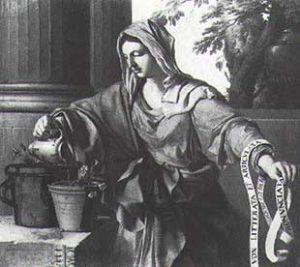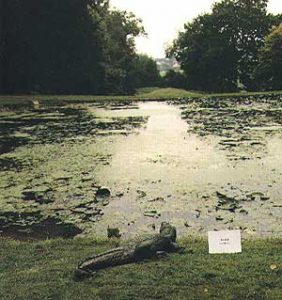TPE: Emblem 2
ICONOLOGY. Learning to capture the identifying gesture and attributes of the wide image in an emblem has as relay an ancient tradition.
 This pictorial tradition can be traced back to an engraving by Marc Antonio. It shows an almost naked woman of Giorgionesque type watering a flower. This enigmatic motif can be explained with the help of the literary tradition. It is a symbol of “Grammatica.” As the plant grows through watering so the young mind is formed through the study of grammar. In late antiquity grammar became the foundation of the liberal arts. This pictorial tradition can be traced back to an engraving by Marc Antonio. It shows an almost naked woman of Giorgionesque type watering a flower. This enigmatic motif can be explained with the help of the literary tradition. It is a symbol of “Grammatica.” As the plant grows through watering so the young mind is formed through the study of grammar. In late antiquity grammar became the foundation of the liberal arts.Rudolf Wittkower, Allegory and the Migration of Symbols, Thames and Hudson, 1977.Wittkower inventories some of the related features associated with Grammar in her allegorical representations: “an old woman carrying a vessel which is supposed to contain medicine for correcting the children’s pronunciation and a knife for sharpening their defective tongues. She also holds a file, with which the grammatical mistakes can be removed.” Ultimately, the watering of the flower became the chief motif of the allegory. |

_________
–Artist Appropriations.With the renewed interest in allegory associated with postmodernism, contemporary artists have brought photography to bear on the tradition of iconology, as in this work.
“The Tears of Concupiscence”
from the series Imprese by Olivier Richon
Other Than Itself: Writing Photography Eds. John X. Berger and Olivier Richon, Cornerhouse Publications, 1989.
How would you picture “ardent, sensuous longing” (lust)?
–From the Archive:
Here is one example of an emblem, taken from Geffrey Whitney’s Choice of Emblemes, published in Leiden by Christopher Plantin in 1586. It is the first full-fledged English emblem book in the continental style, and uses woodblocks from a number of other emblem books, the most important of which is Alciato’s Emblematum liber. (www.mun.ca/alciato/wcomm.html)
Dissidia inter aequales, pessima
(Disputes among equals are the worst)
The Swallowe swifte, dothe beare unto her neste The Grasshopper, that did no daunger feare, For that shee thought, the lov'de togeather beste, Bycause they both, observ'de one time of yeare, And bothe, did joye theire jarring notes to sounde, And neare the house they bothe, theire dwellings founde. Yet time, and tune, and neighbourhood forgotte, For perfect frende, a tyrant shee became, Which taxeth those, whome God dothe heare allotte Like gifts of grace, to winne a lasting name, Yet Envie soe theire vertues doth deface, It makes them foes, to them theie should imbrace.

